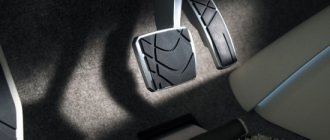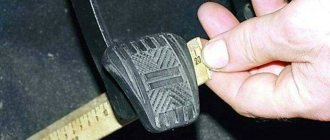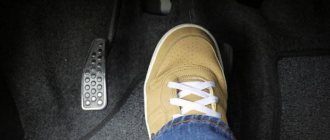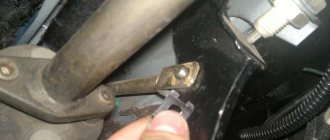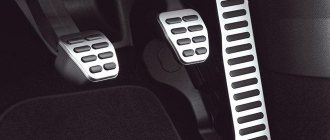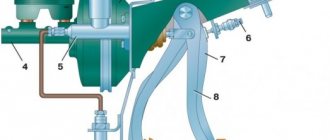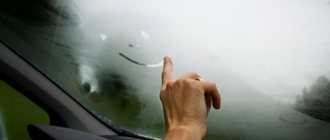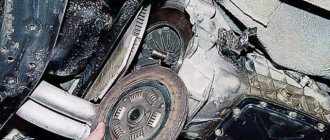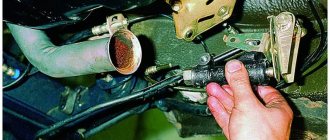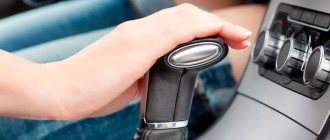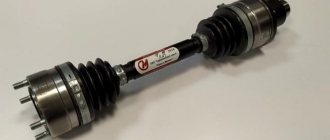How is air formed in the system?
- The level of fuel fluid in the tank is low, as a result of which the liquid leaves it when force is applied to the pedal, sucking in air.
- Severe wear of the pads with a minimum fluid level leads to air intake.
- An error when purchasing the correct TZ leads to incorrect operation of the entire system (collapses).
- Overheating of the hydraulic system and, as a result, boiling of the liquid. The pedal drops sharply.
- Minor depressurization, which causes air to be sucked in. There is no leakage of fuel fluid.
- The system has not been bled.
Sometimes the diaphragm of a vacuum booster breaks, and as a result, at the required level of fluid pressure, the pedal fails because the damaged diaphragm cannot create a vacuum in the chamber. This defect can be determined with the engine running.
A jumpy pedal movement indicates that the pads or calipers are not properly attached. But this behavior of the brakes happens during the running-in of new pads.
Diagnostics using ODB-2 scanner
Content
Since there are many reasons for the malfunction, first of all it is worth carrying out a comprehensive diagnosis of the car. This can be done most quickly using an ODB2 scanner.
Scan Tool Pro Black Edition
A special feature of Scan Tool Pro is the diagnosis of not only the engine, but also other vehicle components (gearbox, transmission, abs, etc.). After reading the errors, you will most likely know exactly the cause of the malfunction (problem in the pump, pressure regulator, lean fuel mixture, malfunction of one of the sensors), after which you should first pay attention to this element. The scanner is compatible with most models of the domestic automobile industry since 1993 and is designed specifically for the CIS - error codes with their interpretation are displayed in Russian.
Emergency situation
Brake failure while driving can be very dangerous. In this case, the main thing is not to panic. You need to smoothly tighten the handbrake, then, if the car has a manual transmission, gradually shift to lower gears.
During switching, be sure to re-throttle to equalize the rotation speed of the primary and secondary shafts. If possible, it is better to drive into a roadside obstacle than into an oncoming car.
Tools
But it is important to know how to properly bleed the brakes on VAZs of different models and what is required for this. The operation itself is not complicated, so you can do it yourself. But it’s better to do this with an assistant - it will be both faster and easier.
Not many tools are required:
- Key for 8 (10);
- Silicone transparent tube according to the diameter of the fitting;
- Capacity;
- Brake fluid;
As for the wrench, you should use the cap type. There are also special keys on the market for unscrewing fittings, clamping. The fact is that the fittings often stick to the thread and are very difficult to unscrew. Using a regular open-end tool, you can easily “lick” the edges and then it will be completely impossible to unscrew the fitting.
The essence of pumping work is almost the same for all cars - VAZ-2101, VAZ-21099, and VAZ-2121 Niva. But the sequence of operations is affected only by the design features of the models.
TOP - most common brake failures
Brake fluid is leaking. It is easy to determine this defect - with each press of the pedal, the amount of liquid in the tank decreases. Air comes in its place. The TJ must be between the minimum and maximum marks on the expansion tank of any car.
When approaching the minimum position, it is worth checking the entire brake system to detect leaks. “Brake fluid” does not evaporate well, and the decrease in level should not be attributed to this.
You should look for traces of leakage, first of all, on the calipers and wheels. You need to drive away; “greasy” stains from the fuel oil are clearly visible on the road surface. Under the hood, marks can be seen on the master cylinder, and sometimes the plastic reservoir leaks.
The most common cause of a leak is wear on the master cylinder. After eliminating the cause, it is necessary to bleed the entire hydraulic system.
Air in the brake system
Air can remain in the hydraulic system without fluid leaking. It is difficult for one driver to determine the problem.
- If you look at the expander with the pedal not depressed, the level will be normal.
- When pressed, the air plug will compress and the fuel fluid will escape.
- If the plug is large, the liquid may disappear completely.
After releasing the pedal, everything falls into place. An experienced driver can identify this malfunction - the pedal becomes “wobbly”. The problem can be solved by high-quality bleeding of the brakes.
Liquid quality
TFs consist of three main components: solvent up to 80%, base up to 30% and various additives make up up to 5% of the composition.
- Not all liquids can be mixed; their compositions react when mixed.
- The mixture collapses with complete loss of properties. In addition, there are counterfeits that violate manufacturing technology, and all rubber parts may dissolve.
- The malfunction can be solved by replacing the fluid; you may have to flush the entire brake part of the car.
Master brake cylinder
The purpose of this machine unit can be understood from the name. There is nothing particularly broken in this part; faults can be eliminated by replacing the repair kit. But metal also wears out, and replacing rubber elements will not always solve the problem.
Therefore, it is safer to replace the entire part. It is not always easy to determine if the master cylinder is faulty - it can suck in air and still leak fluid.
Long fluid life
According to the recommendations of manufacturers, replacement of TK should be carried out every 30 - 60 thousand km. After this period, it completely loses its properties. The boiling point drops from 260, which can lead to complete brake failure.
Car owners do not believe in such a short period of time and change it after 100,000 and even 200,000 km.
Large pedal free play
Caused by an increased gap between the pedal and the vacuum booster. It is easy to determine by the transmission of force to the pedal. Occurs after manipulations with the brake system.
Increased gap between lining and drum
Due to wear of the linings and the drum itself, the distance between them increases. The pedal, not meeting any resistance from the vehicle, falls through. On some cars the clearances can be adjusted, on others the pads and drums need to be replaced.
Hub problem
Loose hub mounts cause the brake pedal to sag. The malfunction is especially noticeable when turning. You can determine it on a suspended car by shaking the wheels with your hands.
Pad wear
This point has something in common with point 7. Here we are talking about disc brakes. The solution to the problem is seen in replacing the linings, possibly discs.
Brake overheating
It occurs quite rarely, but the symptoms are still the same: pedal failure. You need to stop and let the brakes cool down. It may be enough to change your driving style. You should not check the temperature of the brake elements with your hand; you may get burned.
Cold jerks
Some VAZ 2110 drivers say that the jerking starts when it’s cold, and when the car warms up, they disappear.
The most important reason is a lean mixture and therefore air is sucked in at idle. But it is possible that one of the sensors has failed. If such jerks begin to repeat periodically, whether idling or while driving, you need to check:
- Candles, when they are heavily sooted, they lose contact with the wires, and this needs to be corrected urgently. They should be replaced or the contacts should be cleaned and secured.
- High-voltage wires should be checked with a multimeter, and if they have lost their appearance, it is best to completely replace them.
- The ignition coil, here you need to check the armored wires and the ignition module itself. But the test should be carried out with rubber gloves, otherwise you may get an electric shock.
- The timing belt often jumps several teeth and jerking may occur when running cold. First of all, you should check the marks, and if the belt has slipped, you need to remove it and install it as expected.
- Be sure to check all the sensors on the car; if there are faulty ones, then urgently replace them.
- The filter is checked first, because the air and fuel filters are responsible for supplying a clean mixture to the car engine. Here, fuel consumption immediately increases and they need to be changed after a certain period of time.
But there are cases when everything has been checked and what needs to be fixed, but the problem does not disappear, in this situation you need to rebuild the engine, the problem may be in it.
- On fuel-injected cars, fuel injectors often become clogged; in this case, it is better to diagnose the car.
- Of course, you shouldn’t miss the fact that the car was filled with low-quality fuel, and these twitching and jerking can occur precisely because of this; it’s also worth checking the car’s fuel system right away.
And in conclusion, we can say that only high-quality fuel should be poured into the car and in proven places. After all, low-quality fuel can damage all systems in a car. In this case, you can end up with expensive car repairs.
Another piece of advice is to change all components and parts on time, and also periodically carry out diagnostics of the car and the engine separately. Troubles can happen to any car, but the main thing is to find the cause and fix the problem in time, because this is safety on the road.
Photo instructions for diagnosing and repairing car brakes
The rear right wheel of the VAZ 2110 does not bleed: reason
malega View profile Tol466 View profile Thyssen View profile Tol466 View profile Thyssen View profile Boris View profile Tol466 View profile Thyssen View profile krecc View profile leo View profile krecc View profile Tol466 View profile krecc View profile The flap floats and does not freeze
if you fill even more than max. . then the spring does not allow it to open. What I did was written above. Yesterday it was normal, what happened is unclear.
Added: After all, I topped it up to max., when braking, the light blinked.
Posts 6
1 Topic by Deathmish 2014-03-26 15:29:54
Topic: Resolved: Right rear wheel does not brake.
Hello, I noticed that the rear right wheel was not braking, I thought about what the reasons might be and decided to change the pads and cylinders on both wheels. After the replacement, when bleeding the brakes, I saw that the right cylinder was NOT getting any fluid. What could be the reason? Has the sorcerer really flown?
2 Reply from sergo9531 2014-03-26 17:15:01 (2014-03-26 17:27:42 edited by sergo9531)
It's such an idiotic system. Perhaps the sorcerer himself is poorly regulated. I tried to adjust it for a whole month, but it didn’t work (there was a similar situation, maybe I did something wrong). Or the valve is stuck/clogged. You can try to disassemble and clean it. in this case, it is advisable to replace the copper ring.
3 Reply from Sergey VAZ 2111 2014-03-26 21:55:12
Change the sorcerer or go over it. Although I heard that the tubes get clogged.
4 Reply from kapelkaK 2014-03-26 22:11:08
And the hoses delaminate due to age.
5 Reply from AntoxA 2014-03-27 21:36:31
YES, look, the sorcerer, well, such a problem will set him up, I tried for a week more than once a day, I couldn’t stand it and threw it out straight and replaced it with a tee.
6 Reply from Deathmish 2014-03-31 18:24:55
Thanks to all. I solved the problem. The reason was indeed the incorrect adjustment of the sorcerer.
Why do you need a pressure regulator?
Not every owner of a domestic “ten” will understand why the brake pressure regulator on a VAZ 2110 needs to be replaced. Simply, this name is not familiar to everyone. A popular designation for a regulator is a sorcerer.
This very sorcerer is located on the rear suspension of your car. It has a lever with a movable position. Depending on the moment of load on the spring, its position changes.
The voltage generated during actuation is directed and distributed to the brake piston. Pressing the piston pedal reduces the load on the rear pads. If the brake system is working properly, the loads are distributed evenly.
In order for the unit to function efficiently and without errors, it is necessary to adjust the brake pressure regulator on your VAZ 2110. This way you can prevent untimely wheel locking.
Which cylinder is best to buy for replacement?
Rear brake cylinder from Kraft.
If you definitely decide for yourself that you will not go to a service station for repairs, then the spare part necessary for repairs will need to be purchased at a car store. Since spare parts for domestic cars are inexpensive, there will be no problems when purchasing.
When purchasing, you can buy both the original, which has the article number 21050-3502040-00 , and a “non-original” from another company. Unlike spare parts for foreign cars, where the original spare part is always better, the situation with spare parts for VAZ is the opposite. It often happens that non-original spare parts turn out to be of higher quality than the original.
